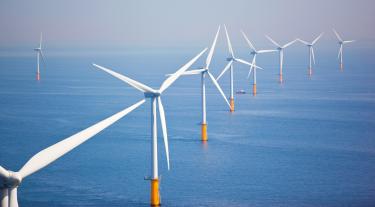- Strike price: The low administrative strike price set at £44/MWh for fixed offshore wind, lower than the wholesale price, poses a significant hurdle within the context of Allocation Round 5 as it doesn’t feasibly allow for any bids.
- Interest rate sensitivity: Offshore wind projects typically demand substantial upfront capital investment, rendering them sensitive to interest rates. The prolonged period of historically low interest rates has translated into remarkably competitive CfD bids. Nonetheless, the abrupt rise in global interest rates, exposes a need to re-evaluate CfD terms.
- Global investment landscape: Several regions and countries are intensifying their commitment to supporting low carbon initiatives, as we see on a range of first time tenders such as in Norway, Ireland, Lithuania, Colombia and Australia. Also a number of initiatives such as the US Inflation Reduction Act are bolstering investment in the green sector. Given the supply chain constraints and lower returns within the UK, developers are exploring alternative markets that appear more competitive.
- Inflationary pressures: High inflation, particularly within sectors like Basic Metals and Fabricated Products, has emerged as a relevant concern. The extent to which these inflationary pressures impact projects depend on hedging strategies. However, during the CfD bidding process, it's likely that these costs were not fully hedged, necessitating an adjustment in CfD terms.
- Changing CfD Terms and Conditions: The evolving landscape of CfD terms and conditions has added complexity to the equation. In Round 4 contracts, the introduction of a 1-hour negative price provision was a notable change. This provision implies that if the day-ahead price turns negative during any hour, the generator won't receive CfD payments for that hour, reducing the expected value for projects. Round 5 contracts have removed the optionality that was present in previous rounds. Earlier, generators had the discretion to trigger the CfD contract when market prices substantially exceeded agreed strike prices during project commissioning. This option has been eliminated in Round 5, which has diminished the overall value of CfDs.
There are two ways to interpret this situation. On one hand, the absence of bids might suggest that developers could potentially withdraw from projects entirely. On the other hand, it's indicative of developers exploring more attractive avenues outside the CfD framework.
Evidence suggests that the reality lies somewhere in between. Project development isn’t coming to a complete halt, and there’s a notable trend of developers opting for alternative approaches. For instance, BP has publicly expressed its intention to explore alternative avenues, while Moray West has successfully reached financial close with 52% of its generation backed by Corporate Power Purchase Agreement (CPPA), a notable achievement considering it was only one-third backed by CfD.
Together, these factors reinforce the dynamic and evolving nature of the offshore wind energy landscape. Whilst challenges persist, it's encouraging to witness the offshore wind industry's adaptability with developers actively exploring new pathways to advance their projects, demonstrating resilience and innovation in the face of evolving market dynamics.
However, to ensure we maintain a focus on delivering low carbon energy at the lowest cost to the consumer it is essential to review and adapt CfD mechanisms and incentives to ensure the continued growth and sustainability of this important sector. We encourage stakeholders and policymakers to engage in constructive dialogue to address these challenges and pave the way for an effective and inclusive clean energy transition.


